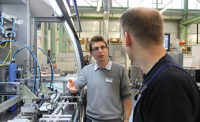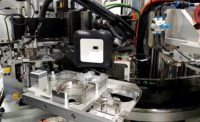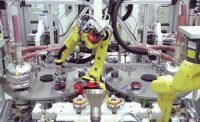WIKA Alexander Wiegand SE & Co. is a leading provider of technology for measuring pressure, temperature, fill level, flow and force. The company has production facilities in Australia, Brazil, China, India, Canada, Germany, Poland, South Africa, the United States, Switzerland and Italy. In two Polish plants employing approximately 2,300 people, WIKA assembles more than 30 million devices annually.
Despite such a large volume, high-mix production is also a concern. For example, WIKA’s factory in Wloclawek, Poland, assembles more than 10,000 product variants. Runs can range from one piece to thousands of pieces. To increase productivity, WIKA engineers decided to automate assembly of pressure gauges and implement Industry 4.0 concepts. The gauges are used for medical and welding applications, so they must withstand pressures of up to 400 bar.
“During one shift, we sometimes have to retool the lines for assembling pressure gauges 15 to 20 times,” says Mario Scheffner, technical director for WIKA in Poland. “This doesn’t happen with every shift, but it’s happening more and more as series become shorter, and we want production flexibility.”
Until recently, partially automated assembly of pressure gauges was carried out using two rotary transfer machines. They enable short cycles and efficient production of large numbers of pieces. However, their retooling requires time-consuming mechanical work. Moreover, in some variants there are additional semi-finished products that must be delivered to another machine.
“We needed a line with 20 stations, including assembly, punching, measuring springs, calibration, visual inspection, screwdriving and marking,” explains Scheffner.
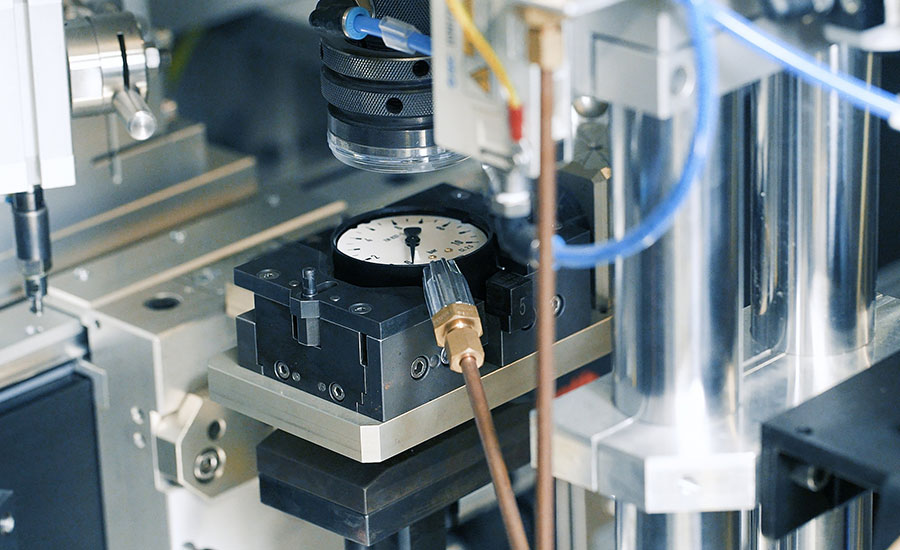
The Active Mover system shortens setup times and increases productivity. Photo courtesy Bosch Rexroth Corp.
After some research, WIKA decided to build a line around the Active Mover transport system from Bosch Rexroth Corp. The Active Mover system works on the principle of a “smart” track—consisting of multiple linear servomotors—and a “dumb” mover outfitted with powerful magnets. Coordinating the activation of electromagnetic coils in the motors propels the movers around the track. Straight and curved segments can be combined to create a closed oval.
Pallets move independently along the entire length of the line, landing precisely at designated positions. It is also possible to change the direction of movement and move to different positions within one station.
The Active Mover can move pallets at a maximum speed of 150 meters per minute and a maximum acceleration of 4 g for a 1-kilogram payload or 1 g for a 10-kilogram payload. Pallets are 165 millimeters wide and can carry a fixture as wide as 500 millimeters. Maximum payload per pallet is 10 kilograms.
An integrated measuring system ensures precise indexing of the pallets, eliminating the need for lift-and-locate units. Stop positions, set via software, can be anywhere around the system, even curves. Positional repeatability is ±0.01 millimeter. The conveyor communicates via ProfiNet or Ethernet I/P with any process control system.
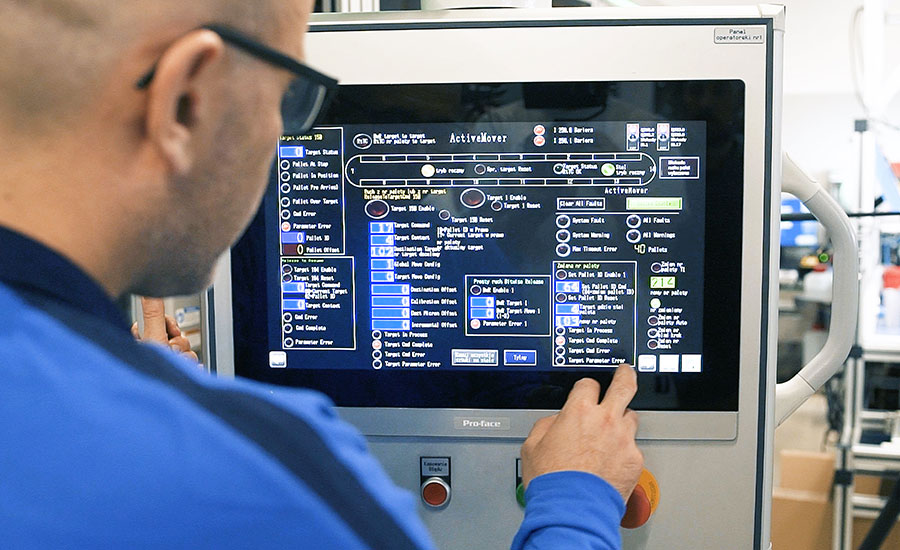
The new line connects seamlessly with WIKA’s MES system. Photo courtesy Bosch Rexroth Corp.
From 20 Minutes to 0 Seconds
The project was dubbed Automatic Gauge Assembly, or AGA 1. The decisive advantage of AGA 1 is shorter setup times.
“For rotary transfer machines, switching to different gauge sizes and port locations took 20 to 25 minutes. With AGA 1, it is 0 seconds,” says Scheffner.
The new line reduces setup times by more than 50 percent. High system dynamics also brings other benefits in terms of productivity. Fast acceleration shortens the transfer time between stations, which reduces the entire cycle time on the line to a minimum.
Another benefit is that the line is compatible with any MES system, says Piotr Krotki, director of automation at WIKA. As a result, information about the production batch to be assembled is loaded via a QR code or bar code.
“The machine is up to 70 to 80 percent self-configuring,” explains Krotki, who is responsible for line design, programming of controllers, and launching production installations.
Depending on the variant to be assembled, freely programmable pallets are placed in different positions at individual stations. This significantly increases overall equipment effectiveness (OEE) and reduces the amount of time-consuming manual work required during setup. At the same time, the line fully documents each automated assembly step, thus meeting increasingly frequent customer traceability requirements.
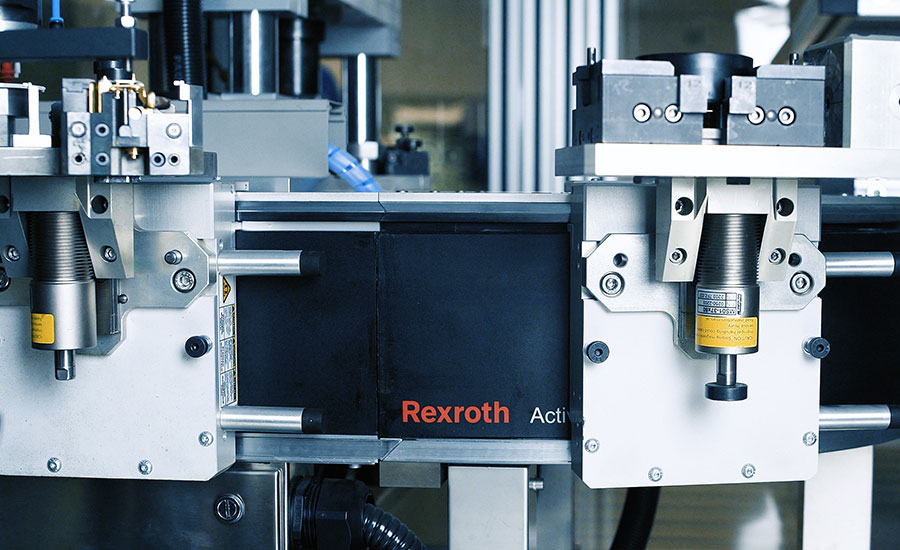
Pallets move independently along the entire length of the line, landing precisely at designated positions. Photo courtesy Bosch Rexroth Corp.
“Thanks to open interfaces, the motion control technology for the Active Mover system integrates with our installation controller via the Profinet interface,” says Krotki.
“Five stations also move in the Z axis,” points out Scheffner. At two test stations, where particularly high positioning accuracy is required, WIKA used additional ML3 linear motors, compact IndraDrive CS drives and ball rail guides with an integrated inductive measurement system. They were also connected to the plant controller using the Profinet interface.
The electric fields of linear motors do not interfere with the operation of the inductive measurement system. Moreover, it is insensitive to dirt and vibrations and does not require energy-consuming sealing air. WIKA is now implementing the inductive measuring system in its rotary transfer machines, as well.
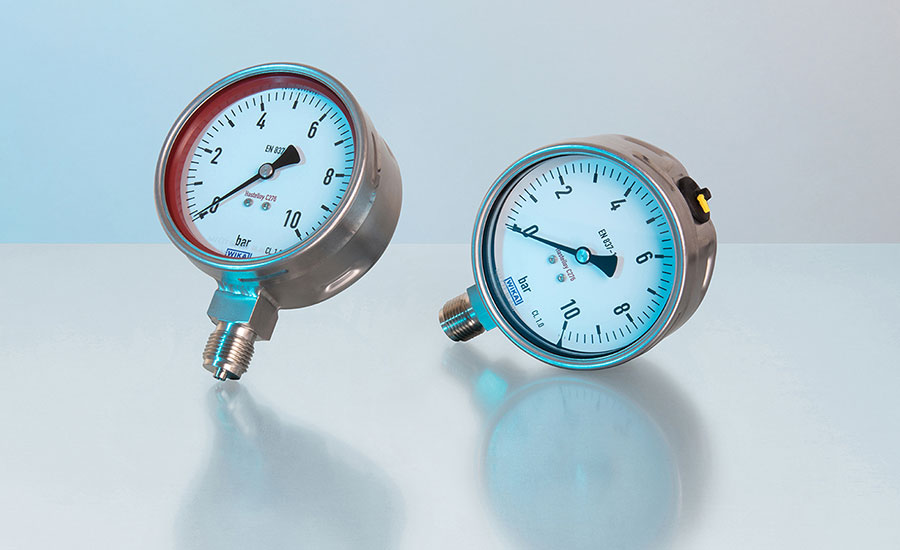
WIKA manufactures a variety of measurement devices, such as this pressure gauge. Photo courtesy WIKA Alexander Wiegand SE & Co.
Wide Force Range
Krotki’s team had previously created a test pallet for assemblies at the Bosch Rexroth plant in Stuttgart, Germany, to construct the AGA 1 system. Comprehensive simulations virtually verified individual process steps. “When programming the PLC, Bosch Rexroth always provided us with the necessary support,” he recalls.
The initial construction and launch of the AGA 1 system took place directly at WIKA’s factory. The frame is made of aluminum profiles from Bosch Rexroth. Thanks to the centering screws and angle brackets, the elements are positioned directly and do not require adjustment. The mechanical system is complemented by an aluminum top. The versatility of the system can be demonstrated by one of the pressing stations: Depending on the variant, forces applied there range from 1.6 to 120 kilonewtons.
The AGA 1 system is still in the startup phase. “We want to ensure quality first, and then we will focus on increasing speed,” emphasizes Scheffner.
However, achieving maximum production speed is already close. The installation is already considered revolutionary at WIKA, and the company is planning to implement additional linear motor transfer systems for other product lines.
ASSEMBLY ONLINE
For more information on motion control technology, read these articles:
New Technology for Conveyors
Linear Motors Revolutionize Conveyance
Smart Transport System Enables Flexible Assembly

